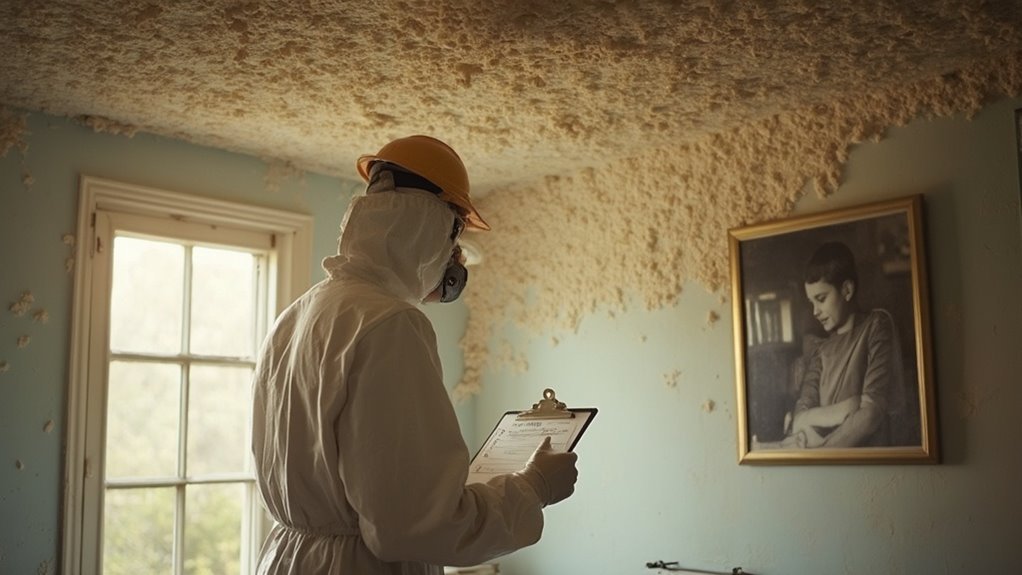Asbestos testing can save your family from serious health risks by identifying hidden dangers before they become a problem. Even minimal exposure to asbestos fibers can lead to severe diseases like lung cancer or mesothelioma, often years down the line. It's vital to recognize that secondary exposure, especially from contaminated clothing, poses significant threats, particularly to children. Regular testing and professional services guarantee that you're aware of any asbestos presence in your home, promoting a safer living environment. Understanding the importance of testing can empower you to protect your loved ones effectively. There's much more to investigate about this essential health concern.
Understanding Asbestos Hazards

As you investigate understanding asbestos hazards, it's important to recognize that even minimal exposure can lead to serious health risks. Asbestos is a group of naturally occurring minerals that can release microscopic airborne fibers when disturbed. Once inhaled, these fibers lodge in your lung tissue, leading to inflammation and scarring. The health effects associated with asbestos exposure are severe and include asbestosis, lung cancer, and mesothelioma, among other diseases. Increased risk of lung cancer and mesothelioma is particularly pronounced among individuals with significant exposure to asbestos. Additionally, professional testing is crucial for accurately identifying asbestos presence in your home environment.
No amount of asbestos is considered safe, and the risks increase with long-term exposure. Asbestos regulations have been enacted to limit exposure, particularly in occupational settings where workers face heightened risks. Nonetheless, risks persist in residential environments, especially in older homes built before the 1980s, where damaged asbestos materials can release fibers.
To protect yourself and your family, regular testing for asbestos in your home is vital. If asbestos is found, it's important to hire licensed professionals for safe removal or repair. Understanding these hazards can help you make knowledgeable choices that safeguard your health and well-being.
The Impact of Secondary Exposure
Secondary exposure to asbestos poses significant health risks, especially for those who may not have directly worked with the material. Family health can be severely impacted when asbestos fibers are unwittingly transferred from contaminated clothing or hair of workers to their loved ones.
Here are common scenarios of secondary exposure:
| Source of Exposure | Risk Level |
|---|---|
| Handling contaminated clothing | High |
| Close physical contact with workers | High |
| Living near asbestos mines/factories | Moderate |
| Washing work clothes at home | High |
| Vacuuming or cleaning household dust | Moderate |
When workers in high-risk industries like construction or manufacturing bring home asbestos fibers, family members can encounter these toxic particles through everyday interactions. Women and children, in particular, are disproportionately affected. The health risks mirror those faced by workers, with potential consequences including mesothelioma and lung cancer. Furthermore, asbestos exposure can occur even from low-level contact, which emphasizes the importance of vigilance in prevention.
To mitigate these risks, it's essential for workers to adopt preventive measures, such as changing out of contaminated clothing before returning home. Being aware of secondary exposure helps protect your family's health from the hidden dangers of asbestos.
Common Asbestos-Related Diseases

Exposure to asbestos can lead to a range of serious health issues, including both cancerous and non-cancerous diseases. Among the cancerous conditions, mesothelioma stands out as a rare and aggressive cancer affecting the linings of the lungs, abdomen, or heart. Lung cancer and laryngeal cancer likewise show increased risks linked to asbestos exposure, particularly in smokers. Non-cancerous diseases include asbestosis, a chronic lung condition that causes scarring and difficulty breathing, and chronic obstructive pulmonary disease (COPD), which can result from inhaling asbestos fibers.
You might experience asbestos symptoms like persistent cough, shortness of breath, or chest pain, which can indicate serious health problems. Treatment options vary depending on the disease; for cancers, surgery, chemotherapy, and radiation are common, while non-cancerous conditions often focus on symptom management and pulmonary rehabilitation. It's essential to recognize these diseases early, as symptoms may not appear until years after exposure. With millions potentially exposed, understanding the risks associated with asbestos can empower you to seek timely medical advice and appropriate interventions.
Recognizing Asbestos Sources
Recognizing asbestos sources in your environment is vital for safeguarding your health. Asbestos can be found in various common materials, especially in older buildings, so it's important to identify potential risks. Use asbestos identification techniques to inspect ceiling tiles, floor tiles, and vinyl or asphalt flooring, as these may contain asbestos.
In addition to flooring, consider cement products like shingles and siding, which historically included asbestos. Insulating materials, such as vermiculite and older cement-based insulation, are also typical asbestos materials.
Look out for automotive products too; brake linings, pads, and clutch plates often contained asbestos. Gasket materials found in furnaces and stoves may pose a risk as well, along with electrical components like cloth wire insulation.
Interestingly, even textured paints and patching compounds used on walls and ceilings can harbor asbestos. Don't overlook less obvious sources like chalkboards, fireproofing materials, and certain old appliances. Regular visual inspections can help you assess the condition of these materials, but remember that professional evaluation is the safest course of action when asbestos is suspected.
Importance of Asbestos Testing

As you navigate the complexities of building maintenance and renovation, understanding the importance of asbestos testing becomes vital for guaranteeing safety and compliance. Regular testing not only adheres to asbestos regulations but in addition protects your family from the potential health hazards associated with asbestos exposure.
Consider the following benefits of asbestos testing:
- Identifying hidden dangers: Uncover asbestos-containing materials that could pose risks during renovations.
- Legal compliance: Meet the mandatory testing frequency required by law to avoid costly penalties.
- Protecting your environment: Assess and manage any asbestos contamination that may impact your surroundings.
Failing to conduct proper asbestos testing can lead to significant legal and financial consequences, especially during demolition or renovation of older properties. It's vital for obtaining necessary permits and guarantees compliance with environmental standards. Additionally, developing effective remediation plans relies heavily on identifying the extent of asbestos contamination. By prioritizing asbestos testing, you not only safeguard your family's health but fulfill your legal obligations, creating a safer living environment for everyone involved. Remember, timely and efficient testing can save lives and prevent costly future problems.
Safe Asbestos Removal Practices
Safe asbestos removal practices are critical to minimizing health risks during the hazardous process of dealing with asbestos-containing materials (ACMs). To protect both workers and occupants, start by erecting physical barriers with plastic sheeting and duct tape to create a containment enclosure. Implement engineering controls like negative air pressure units and HEPA filtration systems to prevent the spread of asbestos fibers.
Prioritize worker safety measures by equipping your team with proper personal protective equipment (PPE), including respirators, coveralls, and gloves. Conduct pre-removal briefings to guarantee everyone understands the removal plan and safety protocols. During the process, utilize effective asbestos removal techniques, such as wet removal to saturate ACMs, and controlled dismantling to minimize fiber release.
Seal all openings in the removal area to maintain an airtight environment and restrict access with signage to prevent unauthorized entry. Monitor air quality continuously to detect any airborne fibers. After removal, enforce strict decontamination procedures for both workers and equipment to guarantee that no asbestos fibers escape into the surrounding environment. Following these practices safeguards not just the workers but the health of your entire family.
Regular Inspections and Monitoring

Regular inspections and monitoring play a crucial role in managing environments with asbestos-containing materials (ACMs), ensuring both safety and compliance. By adhering to established inspection protocols and monitoring schedules, you can greatly reduce the risk of asbestos exposure.
Consider the following benefits of regular inspections:
- Detecting damaged ACMs before they release harmful fibers.
- Ensuring compliance with laws and regulations to avoid potential penalties.
- Identifying necessary remediation measures to protect your family's health.
Visual inspections, air sampling, and bulk material analysis are critical methods for evaluating ACM conditions. These activities should be performed by certified professionals, equipped with personal protective equipment (PPE) during evaluations. Schools, for instance, require accredited inspectors to reevaluate ACMs every three years, while surveillance checks occur every six months. Other buildings should establish appropriate reinspection intervals relevant to their specific circumstances.
Additionally, keeping meticulous records of inspections, tests, and abatement efforts is crucial for compliance and future reference. By prioritizing regular inspections and monitoring, you create a safer environment, protecting your loved ones from the serious health risks associated with asbestos.
Legal Rights and Protections
Understanding the legal framework surrounding asbestos exposure is crucial for anyone affected by asbestos-related health issues. You need to know that federal and state regulations govern asbestos claims, offering various legal protections to individuals. Each state has its own laws that define your rights and outline the litigation process, including statutes of limitations that dictate when you can file a claim.
To successfully navigate this process, you may need to meet specific medical criteria and provide considerable evidence demonstrating that asbestos exposure markedly contributed to your illness. This often includes medical records and pathology reports. Furthermore, premises liability laws clarify the responsibilities of property owners regarding asbestos exposure. If you can prove that the owner knew or should have known about hazardous asbestos levels, it strengthens your case.
It's important to understand that regulatory compliance is vital. States enforce stringent rules for asbestos management, and failing to comply can lead to penalties. Armed with this knowledge, you can better protect your rights and pursue the necessary legal avenues if you or a loved one has suffered because of asbestos exposure.
Family Health Risk Reduction

To effectively reduce your family's health risks from asbestos, you need to understand its common sources, especially in older homes. Regular testing for asbestos is essential to identify potential hazards, and safe removal practices are important for minimizing exposure. By staying informed and proactive, you can create a safer environment for your family.
Understand Asbestos Sources
When evaluating potential health risks from asbestos, recognizing its common sources in your home is crucial. Understanding where asbestos may be found can help you take appropriate action to protect your family. Homes built from the 1930s to the 1970s often contain asbestos, and even those constructed as late as 2004 might have it hidden inside.
Here are some common locations to inspect:
- Attics, particularly with vermiculite insulation
- Basements, where building materials may be present
- Vinyl floor tiles, which often contain asbestos
Asbestos was historically used in various building materials, from drywall to duct insulation, because of its fire-resistant properties. Nevertheless, this usage poses significant health risks, especially during DIY renovations or if natural disasters disturb asbestos-containing materials. Asbestos regulations have evolved, but older mobile homes and imported materials may still pose a threat.
Regular Testing Importance
Regular asbestos testing is vital for safeguarding your family's health against the hidden dangers of exposure. Asbestos-related diseases can take decades to develop, so consistent testing helps identify risks before they escalate. It's recommended to conduct asbestos surveys at least every 12 months, adjusting the frequency based on your building's condition and usage.
Here's a concise overview of testing frequency and methods:
| Testing Frequency | Testing Methods |
|---|---|
| At least every 12 months | Professional sample collection |
| After renovations | Detailed assessments |
| If building condition changes | Laboratory analysis |
Using accredited professionals for these tests guarantees accuracy and safety. They'll perform thorough evaluations, minimizing the risk of undetected asbestos fibers, especially in homes built before the 1980s. Remember, even low levels of exposure can pose serious health risks, so proactive testing is fundamental for your family's long-term well-being. Understanding the importance of regular testing not only protects your loved ones but likewise helps you comply with health regulations and promotes a safe living environment. Prioritize testing to mitigate risks and maintain your family's health.
Safe Removal Practices
Identifying risks through regular asbestos testing is just the first step in protecting your family's health; safe removal practices are of equal importance to minimize exposure during the remediation process. Implementing proper safety protocols during asbestos removal not only safeguards workers but likewise your loved ones. Here are key practices to contemplate:
- Erect barriers and signage to prevent unauthorized access.
- Use wet removal techniques to saturate asbestos materials, reducing fiber release.
- Provide personal protective equipment (PPE) to all workers to guarantee their safety.
Before any removal begins, isolate the area using polyethylene sheeting and duct tape. Negative air pressure units and HEPA filtration systems will help contain any airborne asbestos fibers. During the removal process, avoid heavy machinery that can disturb materials aggressively; instead, opt for hand tools for controlled dismantling. After removal, thoroughly clean the area and confirm it remains off-limits until it's verified safe. By following these safe removal practices, you can considerably reduce health risks associated with asbestos exposure, guaranteeing a safer environment for your family.
Resources for Asbestos Concerns
If you're concerned about asbestos exposure, local health departments can be a valuable first stop for information and resources. Furthermore, asbestos testing services offer professional evaluations to identify potential risks in your home. You can likewise find educational resources online that provide guidance on managing asbestos safely and understanding its health implications.
Local Health Departments
Local health departments play a crucial role in addressing asbestos concerns by offering important resources and oversight for safe handling and removal practices. They implement local regulations to guarantee compliance with the Asbestos National Emission Standard for Hazardous Air Pollutants (NESHAP) and oversee health inspections related to asbestos activities.
Consider the following key resources provided by local health departments:
- Guidance on safe asbestos handling: They offer clear protocols for managing asbestos, especially when it's undisturbed.
- Contractor licensing: Only accredited professionals can handle asbestos, minimizing risks associated with improper removal.
- Public education: Health departments educate the community on the dangers of airborne asbestos fibers and the significance of reporting potential issues.
These departments not only help to mitigate health risks but additionally promote community safety. By guaranteeing that schools develop and implement proper management plans, they play a critical role in protecting children and families from exposure. Engaging with your local health department can provide you with the necessary information and support to address any asbestos concerns effectively. Your awareness and proactive approach can make a significant difference in safeguarding your family's health.
Asbestos Testing Services
When dealing with asbestos concerns, utilizing professional asbestos testing services is critical for guaranteeing safety and compliance. Asbestos exposure can lead to severe health risks, making it pivotal to identify and manage asbestos-containing materials properly. The asbestos testing procedures typically begin with a visual inspection by accredited professionals who assess potential risk areas, such as insulation or ceiling tiles.
After the inspection, professionals collect samples for laboratory analysis, which confirms the presence of asbestos fibers. This process can involve air, dust, or physical samples, with results usually available within one to two days. While you may be concerned about asbestos testing costs, investing in professional services is fundamental for your family's health. Attempting to manage asbestos testing on your own can lead to improper handling, potentially increasing exposure risks.
Choosing a qualified inspector or contractor guarantees that testing and any subsequent removal are done safely and effectively. Always verify that the service provider has the necessary training and state accreditation. This way, you can rest easy that your asbestos concerns are addressed accurately and responsibly, safeguarding your home and loved ones.
Educational Resources Online
Accessing educational resources online is vital for anyone concerned about asbestos exposure and its associated health risks. With a wealth of information available, you can improve your understanding and take proactive steps to protect your family. Here are a few key resources to bear in mind:
- ADAO Educational Resource Library for extensive insights on prevention and treatment.
- EPA Asbestos FAQs to clarify handling and testing procedures.
- WHO Asbestos Fact Sheet for global statistics on asbestos-related health impacts.
Online courses and webinars as well provide invaluable learning opportunities. For instance, the EPA offers a series focused on managing asbestos in schools, while the ADAO hosts an annual conference featuring expert discussions. Resource accessibility is key—these materials empower you to identify, test, and safely manage asbestos in your environment.
Frequently Asked Questions
How Can I Identify Asbestos in My Home?
To identify asbestos in your home, look for asbestos signs like damaged materials or fibrous textures. Use professional testing methods for accurate results, as visual inspections alone can't confirm asbestos presence effectively. Safety first!
What Should I Do if I Find Asbestos?
If you find asbestos, don't disturb it. Hire trained professionals for safe asbestos removal, and take health precautions to prevent exposure. Always prioritize your safety and consider the potential risks to your family's health.
Are DIY Asbestos Removal Methods Safe?
DIY asbestos removal isn't safe. You risk exposure without proper safety precautions, and legal restrictions often apply. Hiring professionals guarantees compliance with regulations, minimizing health risks and guaranteeing safe disposal of hazardous materials.
How Much Does Professional Asbestos Testing Cost?
Asbestos testing costs typically range from $231 to $778, averaging around $483. Factors influencing these costs include home size, sample types, and location, impacting the overall expense of professional asbestos testing services.
Can Pets Be Affected by Asbestos Exposure?
When it comes to pet health, you can't afford to ignore asbestos exposure. Pets can develop serious illnesses like mesothelioma from contaminated environments, especially if they're exposed through your clothing or during renovations. Stay vigilant!
